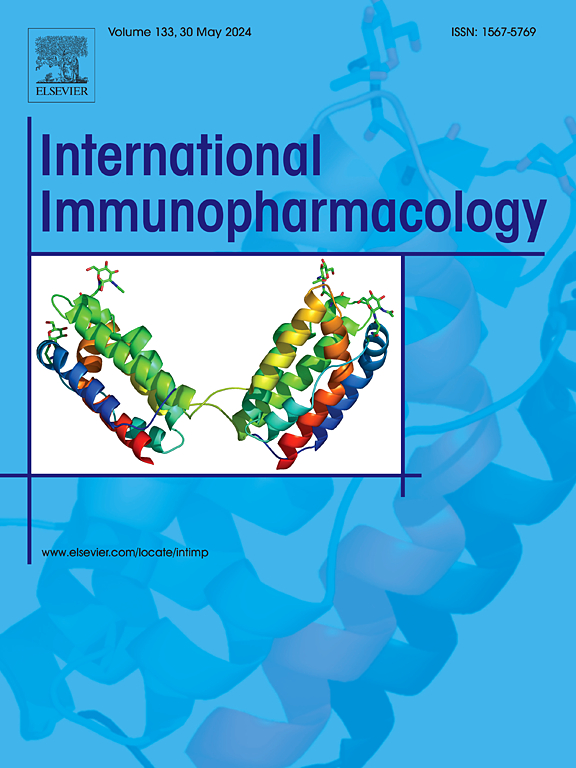Knockdown of GSDMD inhibits pyroptosis in psoriasis by blocking the NOD-like receptor signaling pathway
IF 4.8
2区 医学
Q2 IMMUNOLOGY
引用次数: 0
Abstract
Background
Psoriasis is a chronic inflammatory skin disease regulated by autoimmunity, and pyroptosis plays an important role in this condition. This research sought to examine the function and potential molecular pathway of Gasdermin D (GSDMD) in psoriasis.
Methods
GSDMD expression was examined by immunohistochemistry in biopsied skin tissues from patients with psoriasis. Pyroptosis-related genes and inflammatory factors were quantified using qRT-PCR and ELISA, respectively. HaCaT cells were treated with M5 cytokines to develop an in vitro psoriasis model, while imiquimod (IMQ) was administered to construct an in vivo psoriasis model. To counteract the inhibition of the NOD-like receptor (NLR) pathway caused by GSDMD knockdown, the pathway activator M−TriDAP was employed.
Results
In the lesional skin tissues of patients with psoriasis, GSDMD expression was highly expressed. The levels of pro-pyroptosis mediators were increased, whereas the level of anti-inflammatory factor was lowered. GSDMD knockdown and disulfiram treatment inhibited pyroptosis and promoted apoptosis in M5-induced HaCaT cells. In the IMQ-induced psoriasis-like mouse model, GSDMD knockdown suppressed pyroptosis and improved skin lesion severity, alleviating erythema, epidermal thickness, and inflammatory cell infiltration. Mechanistically, GSDMD knockdown inhibited the NLR pathway, accompanied by reduced protein levels of NLRP3, NOD1, NOD2, and PYCARD. NLR pathway activator, M−TriDAP treatment significantly reversed the effects of GSDMD knockdown on psoriasis progression.
Conclusions
Knockdown of GSDMD inhibits pyroptosis in psoriasis by blocking the NLR signaling pathway, presenting a novel potential strategy for psoriasis treatment.
GSDMD的下调通过阻断nod样受体信号通路抑制银屑病的焦亡。
背景:银屑病是一种由自身免疫调节的慢性炎症性皮肤病,其中焦腐在银屑病中起重要作用。本研究旨在探讨GSDMD在银屑病中的功能和潜在的分子途径。方法:采用免疫组化方法检测银屑病患者皮肤组织中GSDMD的表达。分别采用qRT-PCR和ELISA法对热释热相关基因和炎症因子进行定量分析。用M5细胞因子处理HaCaT细胞建立银屑病体外模型,用咪喹莫特(IMQ)建立银屑病体内模型。为了抵消GSDMD敲低引起的nod样受体(NLR)通路的抑制,我们使用了通路激活剂M-TriDAP。结果:GSDMD在银屑病患者皮损组织中高表达。促焦亡介质水平升高,抗炎因子水平降低。GSDMD敲除和双硫仑处理抑制m5诱导的HaCaT细胞焦亡,促进细胞凋亡。在imq诱导的银屑病样小鼠模型中,GSDMD敲低抑制了焦下垂,改善了皮肤病变严重程度,减轻了红斑、表皮厚度和炎症细胞浸润。在机制上,GSDMD敲低抑制NLR通路,同时NLRP3、NOD1、NOD2和PYCARD蛋白水平降低。NLR通路激活剂M-TriDAP治疗显著逆转GSDMD敲除对银屑病进展的影响。结论:敲低GSDMD通过阻断NLR信号通路抑制银屑病热下垂,为银屑病治疗提供了一种新的潜在策略。
本文章由计算机程序翻译,如有差异,请以英文原文为准。
求助全文
约1分钟内获得全文
求助全文
来源期刊
CiteScore
8.40
自引率
3.60%
发文量
935
审稿时长
53 days
期刊介绍:
International Immunopharmacology is the primary vehicle for the publication of original research papers pertinent to the overlapping areas of immunology, pharmacology, cytokine biology, immunotherapy, immunopathology and immunotoxicology. Review articles that encompass these subjects are also welcome.
The subject material appropriate for submission includes:
• Clinical studies employing immunotherapy of any type including the use of: bacterial and chemical agents; thymic hormones, interferon, lymphokines, etc., in transplantation and diseases such as cancer, immunodeficiency, chronic infection and allergic, inflammatory or autoimmune disorders.
• Studies on the mechanisms of action of these agents for specific parameters of immune competence as well as the overall clinical state.
• Pre-clinical animal studies and in vitro studies on mechanisms of action with immunopotentiators, immunomodulators, immunoadjuvants and other pharmacological agents active on cells participating in immune or allergic responses.
• Pharmacological compounds, microbial products and toxicological agents that affect the lymphoid system, and their mechanisms of action.
• Agents that activate genes or modify transcription and translation within the immune response.
• Substances activated, generated, or released through immunologic or related pathways that are pharmacologically active.
• Production, function and regulation of cytokines and their receptors.
• Classical pharmacological studies on the effects of chemokines and bioactive factors released during immunological reactions.

 求助内容:
求助内容: 应助结果提醒方式:
应助结果提醒方式:


